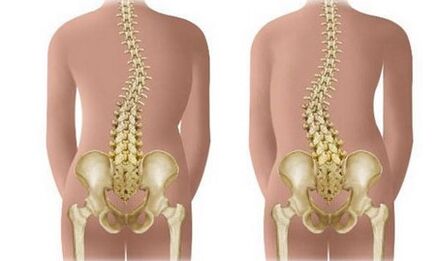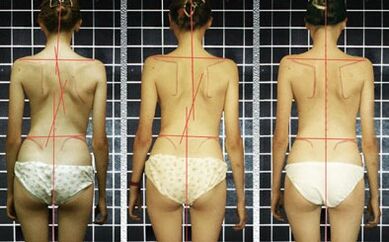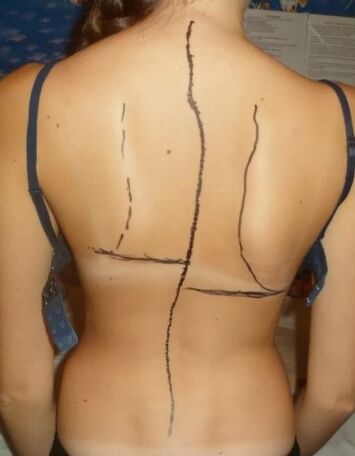In Greek there is the word "Skolios", which translates as "crumant".With this word, doctors refer to the curvature of the spine.In addition, not all curvature, namely the lateral deviation of the vertical axis of the spine.The fact is that our spine is usually not perfect.The bends at the front and back (lord boxes and kyphosis) protect our spine from excessive loads, while the body is maintained in a certain position when moving and carrying weights.Negative processes in our body only develop in cases in which these kyphosis and lord boxes go beyond the permissible norm.

The main problems
Even a small degree of lateral bends (scoliosis) of the spine is always a pathology.And the point is not only in a cosmetic defect.Although a characteristic repulsive appearance with pronounced or progressive scoliosis is always a tragedy for a person who tries to lead a high life life.This applies in particular to boys and girls.In childhood and adolescence (up to 15 to 16 years), a significant part of scoliosis is diagnosed.
The main problem is that due to a change in the configuration and the volume of the breast with a pronounced lateral curvature, internal organs always suffer (heart, lungs, stomach, liver, intestine, large vessels).In men, tolerance against physical exertion decreases, women have problems with conception, pregnancy and birth.In addition, the lateral deformation of the spine is very often only the surface part of the iceberg, which is a sign of a much more serious pathology - tumor, tuberculosis and endocrine disorders.
Reasons
Why is the spine deformed?Before you answer the question, you should choose the types of scoliosis.In essence, scoliosis can be structurally and unstructurally.Due to anatomical changes, structural coliosis develops in the structure of the bone tissue of the vertebrae as well as muscles, nerves and band apparatus nearby.Such curvatures can be acquired and congenital and about a quarter of all diagnosed scoliosis can be identified for the latter.
They differentiate between the main reasons for the development of structural coliosis:

- Masts of intrauterine development that lead to dysplastic diseases of one or more vertebrae
- Congenital breast developmental disorders - lack of ribs, additional ribs
- Congenital pathology of connective tissue - neurofibromatosis, Marfan syndrome
- Brain failure due to the brain paralysis of children (cerebral palsy), which leads to a violation of the innervation of certain parts of the spine
- Osteoporosis (bone cloth) of the spine in rickets, diseases of parathyroid glands, a lack of calcium intake with food
- Osteomyelitis of the vertebrae
- Dystrophic changes in cervical, thoracic and lumbar muscles
- Tuberculosis damage to the vertebrae
- Spine injuries
- Tumors of the spine.
Non -structural scoliosis, as follows, are the lateral deviations of the axis of the spine with the unchanged structure of the vertebrae.As a rule, such scoliosis is most frequently acquired with the exception of cases in which the curvature is naturally compensatory, with anatomical defects of the pelvic or lower extremities.The causes of such scoliosis are most common:
- Pelvic injuries and lower extremities
- Congenital defects of the pelvis and the lower extremities
- Constant inappropriate attitude among school children
- Diseases of internal organs with asymmetrically expressed pain syndrome
- Muscle inflammation (myosites)
- Burns, scars of soft fabrics on one side.
In these cases, it is sufficient to heal the underlying disease to eliminate the curvature of the spine, and therefore many unstructural scoliosis are slightly reversible.In this regard, some doctors tend to expect unstructural deformations for scoliosis in general.

In recent times, cases of scoliosis have become more common with unclear causes.This is the so -called idiopathic scoliosis.It occurs in the youth years in the time of fast body growth.In addition, girls suffer from idiopathic scoliosis several times than young men.Apparently this is due to the relatively weak muscles of the back of the female, which the spine cannot lock in a full muscle frame.An unbalanced diet with low calcium salt and a general passion for young people with carbonated drinks plays a not the last role in developing idiopathic scoliosis.As you know, carbon dioxide in bubbles and orthophosphoric acid in synthetic inclusions contribute to the release of calcium salts from the body.
Consults and degrees
Depending on the localization, scoliosis can be cervical, chest, lumbar or mixed (cervical, lumbar crawl).It is possible to have one or more curvature arches.In this regard, C-shaped scoliosis (with 1 sheet), S-shaped (with 2 arches) and Z-shaped (with 3 arches) are differentiated.Most likely, the presence of 2 or 3 arches is compensatory.With C-shaped scoliosis, the axis of the spine differs.To compensate for this, the spine bends in the opposite direction.In this regard, scoliosis is compensated for and not compensated for.In the event of compensated spine curvature, a vertical line, which is reduced by the 7th cervical vertebra, leaves the buttocks between the buttocks.
The curvature of the spine is often combined.For example, in addition to the lateral curvature, a pathological kyphosis or just a hump is found in the thoracic region.In these cases one speaks of thorax kyphoscoliosis.In addition to the lateral displacement of the vertebrae, the Thuria is found in large degrees of scolios.In a literal translation, this means twisting.In fact, the vertebral bone tissue is twisted along the vertical axis with many scoliosis.
Depending on the size of the curvature archbow, 4 degrees of scoliosis are distinguished:
- 1 degree- The curvature angle does not exceed 10 degrees.Asymmetry according to the eye is practically not determined.The hatchet, the unequal level of the shoulder girdle, pays attention.
- 2 degrees- The curvature angle is 11 to 25 degrees.The vertebrae are already determined to this extent.There is an asymmetry of the shoulder girdle and the pelvis that is visible on the eye.Due to the pathological muscle tension, a muscle roller is formed in the lumbar region from the concave side and in the chest area with a convex.
- 3 degrees- The WRTIFICATION is between 26 and 50 degrees.Visible deformation of the breast - western intercostal rooms C in the concave side of the curvature and plump with convex.Weakening of the abdominal press, the formation of an inner hump.
- 4 degrees- The curvature angle i exceeds 50 degrees.A cosmetic defect and all previous signs are expressed.Low tolerance of even small physical exertion.In addition to the musculoskeletal system, internal organs suffer.

The angle can vary depending on the position of the body, while a stable and unstable scoliosis is differentiated.With unstable scoliosis, it decreases in the lying position when the strain on the spine decreases.With a stable curvature of the spine, this value remains unchanged.
Symptoms
Lately orthopedic surgeons have often been using the term "scoliotics".And they show a complex of negative changes that occurs in the body during the curvature of the spine.As a rule, in childhood and adolescence, during the formation of the movement apparatus.At this point there is a high probability that scoliosis will progress.
Obviously, the intermediate discs play an important role in increasing the curvature angle.In the event of a side shift, the disc experiences unequal pressure through the vertebral bodies.On the concave side, this pressure is larger, with a convex - less.As a result, the disc is created even more from scoliosis, a pathological muscle tension (muscle roller) and the torsion of the vertebrae - all of this leads to the occurrence of windscreen hernia and a further increase in the curvature angle.

Second, the breast changes together with the spine with a scoliotic.The so -called rib hump is formed - on the contrary, the intercostal spaces expand on the convex side of the curvature, they are sown.In the case of scoliosis of the 4th degree, the deformation of the breast is so pronounced that the lower ribs are in contact with the helm on the side of the curvature.
Due to the strong deformation of the breast, a full excursion is difficult during breathing.As a result, the body with severe scoliosis does not get the required amount of oxygen - the so -called chronic hypoxia develops under violation of all metabolic processes in the body.The pathology is tightened by the fact that the internal volume and shape of the chest cavities change.For this reason, blood circulation is disturbed by the vessels, the lungs suffer, the shape of the heart changes, chronically cardiovascular failure.
Similar changes occur in the abdominal organs for lumbar and lumbosacral scoliosis.The authors of the stomach and intestine are reduced with subsequent enzymatic insufficiency of the digestive glands.All of this only worsens metabolic disorders.These violations often lead to a late sexual maturation of boys and girls.In addition, the pelvis is curved a second time due to lumbar spine scoliosis.This creates problems for future mothers with pregnancy and birth.
Diagnosis
The diagnosis of scoliosis, especially usually, is usually not difficult.In order to recognize the deformation of the spine, a frequent visual examination is often sufficient.The visible curvature of the contours of the spine, the asymmetry of the shoulder girdle, the angles of the shoulder blades, the secondary curvature of the pelvis and the shortening of the lower limb at the side of the curvature are remarkable.
In the presence of at least one of these signs, the radiography of the spine is displayed.The X beam determines the configuration, the degree and the localization of the curvature.During the inspection and the radiological examination, it is possible to determine whether the scoliosis is compensated for and stable.A qualitatively new method for researching the spine magnet resonance imaging (MRI) has recently been spread, in which a three-dimensional image of the spine can be preserved on the monitor screen.With considerable curvatures, it is necessary to examine the work of internal organs - a spirometry, electrocardiography and an ultrasound of the heart and the internal organs.
Treatment
The treatment of scoliosis can be carried out both conservatively and immediately.Conservative methods include drug treatment, massage, physiotherapy methods and manual therapy.It should be taken into account that the final formation of the spine ends at the age of 20, and after this age the correction of the curvature is almost impossible.With scoliosis of 1-2 degrees, the efforts aim to achieve the initial normal configuration of the spine.This is unreachable with a pronounced scoliosis of the 3rd to 4. degree.Here is the main thing to stabilize the spine and prevent the progression of scoliosis.

Medicines (chondroprotectors, vitamins, general strengthening of medication) in the treatment of scoliosis only play an auxiliary role.To strengthen the muscles, remove the muscle roller and even to a large extent to stabilize the spine using massage and manual therapy.A good effect is given by physiotherapy exercises.But here the instability of the spine is improved with inadequate physical exertion and the scoliosis progresses.Therefore, a number of exercises are developed individually for each patient, whereby the localization and severity of the curvature is taken into account.With a large degree of scoliosis, running, strength exercises, jumps, outdoor games are contraindicated.
A very good result results in a correction by the position - the optimal pose is created, which contributes to the normalization of the attitude.Special devices are used for this, orthopedic cribs in which young patients spend a significant part of their time.With the ineffectiveness of conservative measures, the progression of curvature and surgical treatment for stabilizing the spine is displayed.The surgical correction is not shown in early childhood, but is carried out in youth when the formation of the spine is almost complete.



















































